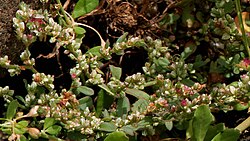Polygonaceae
| Polygonaceae | |
|---|---|

| |
| Persicaria maculosa | |
| Scientific classification | |
| Kingdom: | Plantae |
| Clade: | Tracheophytes |
| Clade: | Angiosperms |
| Clade: | Eudicots |
| Order: | Caryophyllales |
| Family: | Polygonaceae Juss.[1] |
| Subfamilies | |
The Polygonaceae are a
The Polygonaceae comprise about 1200
Several species are
Polygonaceae contain some of the most prolific
Taxonomy
Polygonaceae are very well-defined and have long been universally recognized. In the

The last comprehensive revision of the family was published in 1993 by John Brandbyge as part of
Brandbyge wrote descriptions for 43 genera of Polygonaceae in 1993.
Description

Most Polygonaceae are

Genera
As of March 2019[update], Plants of the World Online accepted 56 genera:[20]
- Acanthoscyphus Small
- Afrobrunnichia Hutch. & Dalziel
- Antigonon Endl.
- Aristocapsa Reveal & Hardham
- Atraphaxis L.
- BactriaYurtseva & Mavrodiev
- Bistorta (L.) Scop.
- Brunnichia Banks ex Gaertn.
- Caelestium Yurtseva & Mavrodiev
- Calligonum L.
- Centrostegia A.Gray
- Chorizanthe R.Br. ex Benth.
- Coccoloba P.Browne
- Dedeckera Reveal & J.T.Howell
- Dodecahema Reveal & C.B.Hardham
- Duma T.M.Schust.
- Enneatypus Herzog
- Eriogonum Michx.
- Eskemukerjea Malick & Sengupta
- Fagopyrum Mill.
- Fallopia Adans.
- Gilmania Coville
- Goodmania Reveal & Ertter
- Gymnopodium Rolfe
- HarfordiaGreene & Parry
- Hollisteria S.Watson
- Johanneshowellia Reveal
- Knorringia (Czukav.) Tzvelev
- Koenigia L.
- Lastarriaea Remy
- Leptogonum Benth.
- Magoniella Adr.Sanchez
- Mucronea Benth.
- Muehlenbeckia Meisn.
- Nemacaulis Nutt.
- Neomillspaughia S.F.Blake
- Oxygonum Burch.
- Oxyria Hill
- Oxytheca Nutt.
- Parogonum (Haraldson) Desjardins & J.P.Bailey
- Persicaria Mill.
- Podopterus Bonpl.
- Polygonum L.
- Pteropyrum Jaub. & Spach
- Pterostegia Fisch. & C.A.Mey.
- Pteroxygonum Dammer & Diels
- × Reyllopia Holub
- Reynoutria Houtt.
- Rheum L.
- Rumex L.
- Ruprechtia C.A.Mey.
- Sidotheca Reveal
- Stenogonum Nutt.
- Symmeria Benth.
- Systenotheca Reveal & Hardham
- Triplaris Loefl.
Former genera
- Aconogonon (Meisn.) Rchb. – now included in Koenigia
- Harpagocarpus Hutch. & Dandy - synonym of Fagopyrum
- Homalocladium (F.Muell.) L.H.Bailey – now included in Muehlenbeckia
- Parapteropyrum A.J.Li – now included in Fagopyrum
- Peutalis Raf. – synonym of Persicaria
- Polygonella Michx. – now included in Polygonum
- Rubrivena M.Král – now included in Koenigia
Phylogeny
The following phylogenetic tree is based on two papers on the molecular phylogenetics of Polygonaceae.[13][14]
| Polygonaceae |
| ||||||||||||||||||||||||||||||||||||||||||||||||||||||||||||
References
- ^ hdl:10654/18083
- ^ Antoine Laurent de Jussieu. 1789. Genera plantarum: secundum ordines naturales disposita, juxta methodum in Horto regio parisiensi exaratam. page 82. Herrisant and Barrois: Paris, France. (see External links below)
- ^ Costea, Mihai; Tardif, François J. & Hinds, Harold R. "Polygonum". In Flora of North America Editorial Committee (ed.). Flora of North America (online). eFloras.org. Archived from the original on 2021-05-06. Retrieved 2019-05-10.
- ^ ISBN 978-0-521-82071-4
- from the original on 2016-07-29. Retrieved 2016-07-14.
- ^ ISBN 978-0-19-522211-1(see External links below)
- ^ ISBN 978-0-387-55509-6(New York)
- ISBN 978-0-333-47494-5(set).
- ^ George W. Staples and Derral R. Herbst "A Tropical Garden Flora" Bishop Museum Press: Honolulu, Hawaii, USA. (2005)
- ISBN 978-1-55407-206-4.
- from the original on 2023-01-20. Retrieved 2020-09-15.
- ^ Peter F. Stevens. 2001 onwards. Angiosperm Phylogeny Website At: Missouri Botanical Garden Website. (see External links below).
- ^ S2CID 84694521.
- ^ PMID 21616890.
- .
- ^ Anjen Li, Bojian Bao, Alisa E. Grabovskaya-Borodina, Suk-pyo Hong, John McNeill, Sergei L. Mosyakin, Hideaki Ohba, and Chong-wook Park. 2003. "Polygonaceae" pages 277-350. In: Zhengyi Wu, Peter H. Raven, and Deyuan Hong (editors). Flora of China volume 5. Science Press: Beijing, China; Missouri Botanical Garden Press: St. Louis, Missouri, USA.
- ISBN 0-07-032795-5
- ISBN 978-0-87893-407-2
- ISBN 978-1-4020-9608-2. (see External links below)
- ^ "Polygonaceae Juss.". Plants of the World Online. Royal Botanic Gardens, Kew. Retrieved 17 April 2024.
External links
- Polygonaceae In: FNA volume 5 In: Family List In: Flora of North America At: eFloras
- Polygonaceae In: Genera Plantarum (Jussieu) At: Genera Plantarum At: Search At: Botanicus.org
- List of Genera in Polygonaceae At: Polygonaceae At: Caryophyllales At: Angiosperm Phylogeny Website At: Missoure Botanical Garden Website
- List of genera in family Polygonaceae At: Dicotyledons At: List Genera within a Family At: Vascular Plant Families and Genera At: About the Checklist At: World Checklist of Selected Plant Families At: Data Sources Archived 2012-09-10 at the Wayback Machine At: ePIC Archived 2012-09-10 at the Wayback Machine At: Scientific Databases At: Kew Gardens
- List of genera At: Polygonaceae At: List of families Archived 2000-08-16 at the Wayback Machine At: Families and Genera in GRIN Archived 2013-02-27 at the Wayback Machine At: Queries At: GRIN taxonomy for plants
- non-core Caryophyllales At: Caryophyllales At: Root of the Tree (Life on Earth) At: Tree of Life web project
- Polygonaceae In: Flowering Plants (Takhtajan)
- Polygonaceae Archived 2007-01-03 at the Wayback Machine in L. Watson and M.J. Dallwitz (1992 onwards). The families of flowering plants: descriptions, illustrations, identification, information retrieval. Archived 2007-01-03 at the Wayback Machine http://delta-intkey.com Archived 2007-01-03 at the Wayback Machine
- Family Polygonaceae Archived 2012-10-11 at the Wayback Machine Flowers in Israel
- Polygonaceae of Mongolia in FloraGREIF
